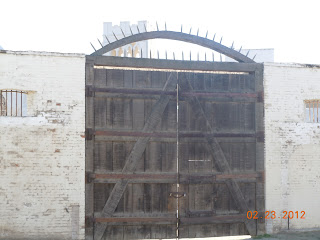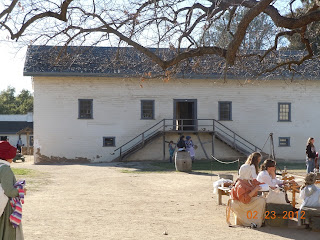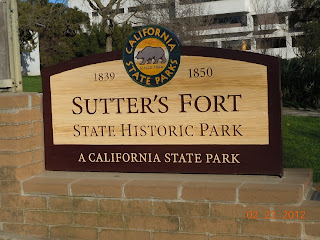 |
| One of the gates at Sutters Fort |
The building of the fort made a lot of sense. It was constructed on a rise near the river and provided some protection from hostile Indians. Not all were hostile, but a certain number were. Also, Sutters Fort became somewhat of a town center. It consolidated many of Sutter's enterprises such as a granaries, a blacksmith shop, store rooms and of course an arsenal.
Touring the fort today, one can stroll around and see these various enterprises within the fort walls as working exhibits of history. Exhibits and demonstrations are held on subjects such as fur trapping, sewing and mending and the art of blacksmithing. This California State Park is probably the most interactive of all State Parks and this helps make a visit there even more fun. Out of all the parks in Sacramento California, this is a must stop. Sutter's Fort Trade Store is operated by the Friends of Sutter's Fort in cooperation with California State Parks. All proceeds fund the educational programs at Sutter's Fort State Historic Park. The Trade Store is located within the fort. A lot of very interesting and educational items can be found there including books, earthenware and art. Fort Sutter schedules many special events and exhibits during the year and quite a few of them are interactive.
 |
| Storehouse within Sutters Fort |
Sutters Fort was also a meeting place of sorts. It was the destination used by immigrants traveling over the Sierra Nevada Mountains, stagecoaches and for a brief time the Pony Express. Sutters Fort was both a working settlement and a major landmark. Sutters Fort would also be the place that rescue parties departed from to try to save the stranded Donner party during the harsh winter of 1846-47. In the book, Anybodys Gold by author Joseph Henry Jackson, the fort was a citadel for Sutter that focused everything. It was his home and office and the place where he sat being the friend and patron of all the valley. here he had furniture purchased from the Russians at Fort Ross, a fireplace, a small table, pens and paper and a candelabrum which furnished light. He also had Indian blankets woven on the forts own looms.
 |
| Sutters Fort boiling pot |
The latter 1840's was a time of great turbulence in northern California. Two big events occurred and they happened at about the same time. First was the gold discovery mentioned above and then it was the end of the Mexican American War which ceded California to the United States. During the Mexican American War and the famous Bear Flag Revolt in 1846 at the start of the Mexican American War, which was an American uprising against Mexican rule which was a bit similar than what occurred in Texas in 1836. The revolt was As it turned out, the Bear Flag Revolt was really unnecessary since the United States took over California after the end of the Mexican American War. What is notable about the Bear Flag Revolt was that it was encouraged by U.S. Army Major John C. Fremont and amazingly also by former Mexican General Mariano Vallejo.
 |
| Covered wagon exhibit on the fort grounds |
There are two other articles that tell more about the history of gold rush towns that you should find interesting. They are the story of Auburn California, just to the west of Sacramento in the Sierra Nevada foothills and also the story of the steamships that carried both men and mail to the California gold fields.
As mentioned, the gold rush really destroyed the holdings of John Sutter. He lost a good deal of the land he had acquired during Mexican rule. To guard against possibly losing everything that remained he deeded his land to his son. Sutters son apparently had little interest in what was going on with the gold mining and concentrated on building a town by the name of Sacramento.Although the father wanted the new town to be named Sutterville, the town of course was named Sacramento.
 The elder Sutter tried to petition the federal government for some type of restitution. Congress was debating a bill that would have given Sutter some $50,000 but nothing had been passed and he died in a Washington D.C. hotel in June of 1880. His body was transported back to his native Switzerland where he was buried in his hometown of Lititz.
The elder Sutter tried to petition the federal government for some type of restitution. Congress was debating a bill that would have given Sutter some $50,000 but nothing had been passed and he died in a Washington D.C. hotel in June of 1880. His body was transported back to his native Switzerland where he was buried in his hometown of Lititz.What's both amazing and at the same time a tragedy was that the dreams of John Sutter and his "New Helvetia" were derailed by what was to many a financial bonanza like never seen before. Just about at the time that Sutter had built up his empire, the end of the Mexican American War would change the California power structure and the Great California Gold Rush would ignite on his land and bring about drastic changes he had no way to control.
If you have the opportunity to plan a California vacation, I believe you would have a great time exploring Sutters Fort and reliving the era of the 1840's, Mexican rule and California statehood. It's an excellent low cost, educational and fun opportunity for the entire family. Other great nearby trip stops are Old Sacramento on the banks of the Sacramento River and the California State Railroad Museum which is in Old Town. The Sacramento train museum is one of the areas top tourist attractions and one of the very best train museums in the United States. (Photos are from author's private collection)

